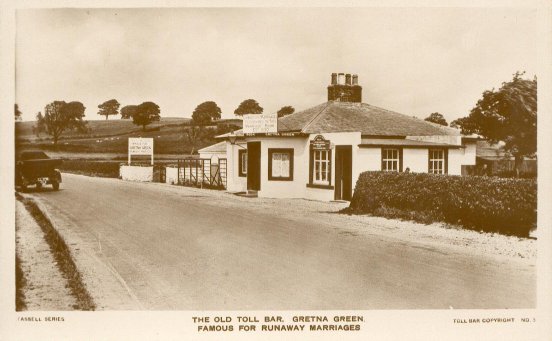 |
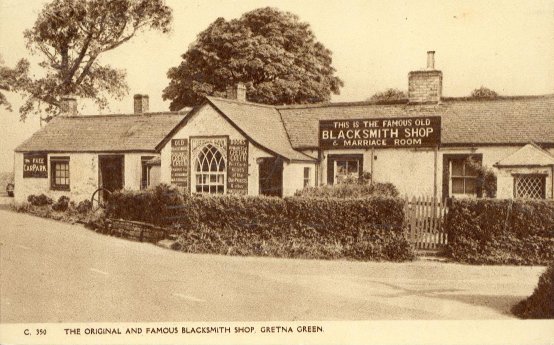 |
Gretna's popularity as a marriage venue dates back to 1754 when Lord Hardwicke's Marriage Act decreed that parental consent was required if either party to a marriage was aged under 21. However, as this Act did not apply in Scotland, a large number of young couples travelled north to Scotland where a valid marriage could be contracted merely by a declaration before two witnesses. Gretna being just a few miles over the border on the London to Edinburgh stagecoach route, became the most popular destination.
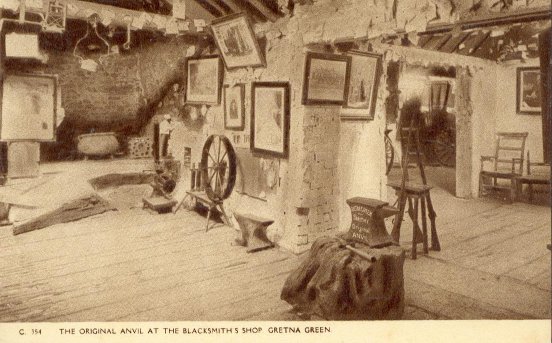 |
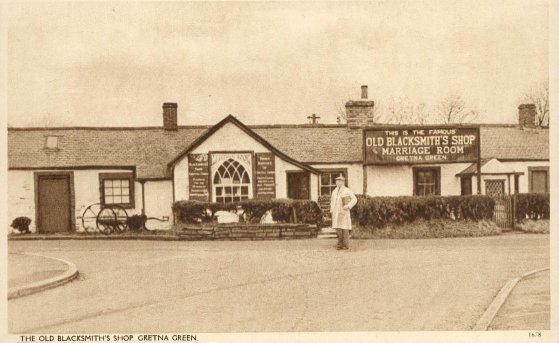 |
Any responsible person was able to conduct the marriage, but the local blacksmith often carried them out "over the anvil". A link with this historical practice has become very popular in recent years, with many ceremonies taking place, for example, at the Old Blacksmith's Shop. In popular folklore, the village blacksmith and the blacksmith's anvil have become the enduring symbols of Gretna Green weddings. As a "forger", the blacksmith marries hot metal to metal over the anvil, in the same way the anvil priests forged a union between couples who had eloped in love. In those days, the village blacksmith was the lifeblood of any village, always at work making horseshoes, fixing carriages and farm equipment in his Blacksmith's workshop. In Gretna Green [NY 32042 68218], the Blacksmith's Shop [NY 32115 68360] was at the heart of the village, at the junction of five old coaching roads, known as "Headless Cross". Over the years, the Blacksmith's Shop became Gretna Green's best-known marriage venue, and the word Blacksmith became synonymous with Gretna Green weddings.
Gretna Green's "Anvil Priests"
In reality, there were many "anvil priests" performing marriages at the Old Toll Bar and in hostelries and coaching inns throughout the village. Gretna Green's anvil priests were a colourful set of characters who setup shop in hostelries and Coaching inns in the village, and made their living from the marriage trade. Many had other occupations - blacksmith, fisherman, weaver, saddler - none of them had any "qualifications" to perform marriages and used Scotland's marriage laws as a way of earning extra money. Some of the more unsavoury anvil priests moved to the village from London after Lord Hardwicke's act put them out of a job by making the irregular marriage trade illegal in England.
To perform a marriage, the anvil priest simply asked the couple to plight their troth in front of two witnesses, and, quick as the bang of a hammer on an anvil, their word was law. If a couple had come unaccompanied, the anvil priest would often knock on a neighbour's door to ask them to come and serve as a witness. If word came that the angry father was fast approaching Gretna Green and there was a risk of the marriage being interrupted, the anvil priest - so the story goes - told the lovers to nip into bed. When the pursuer arrived, he was shown to the bedroom. On seeing the couple in the bed, he assumed he was too late, as the marriage appeared to have been, or was well on the way to being, consummated.
The total number of marriages at Gretna at this time is not known, but over the following 100 years or so it was certainly several tens of thousands. The numbers dropped dramatically after 1857 when Scots Law prescribed certain conditions for "irregular" marriages. Though such marriages were recognised until 1939, they were not included in the official marriage registers. One of the last anvil priests, Richard Rennison, married 5,147 couples in the Blacksmith's Shop before he retired in 1962.
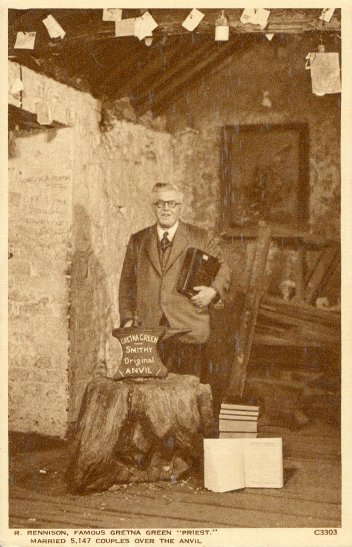
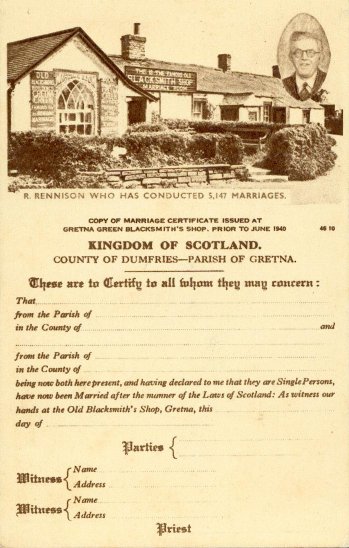
Richard Rennison, Gretna Green "Anvil Priest" 1926 to 1940
Rennison arrived in Gretna Green in 1926 at the time Hugh Mackie was looking for a successor for the position of resident "Priest" at the Blacksmith's Shop. He started "marrying the folk" as he called it, almost immediately. A showman with the gift of the gab, he had the right knack for the job. Rennison came from near Hexham Northumberland, where he had been employed as a saddler. He was dark haired, ruddy of complexion, of average height and rather stout. Rennison was once asked what hours he kept, to which he replied "Doctor's hours" carrying on the tradition of Gretna Green priests of being ready to answer a marriage call at any hour of the day or night. He enjoyed and was proud of "his marrying trade". A great storyteller, one of his favourite tales was how, after attending a funeral on New Year's Day in 1931, he arrived back at the cottage adjacent to the forge to find eight couples on his doorstep waiting to be married!
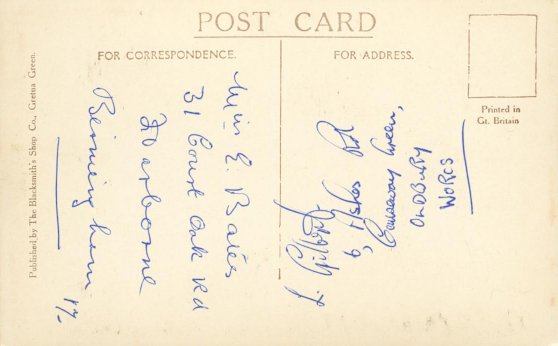 |
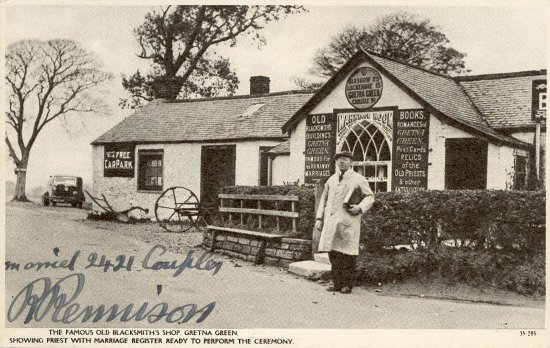 |
| L. Gilbert, 6 Ashes Road, Causeway Green, Oldbury, Worcestershire and Miss E. Bates, 31 Court Oak Road, Harborne, Birmingham 17 | "married 2421 Couples R Rennison" (circa 1932 to 1933) |
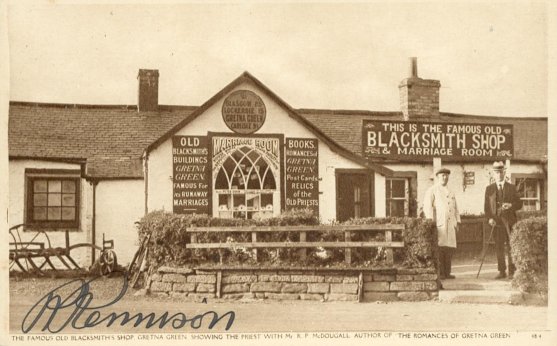
Like his predecessors he lived in the cottage and by the time the law was changed in 1940 he had conducted 5,147 marriages. He continued to work in the Blacksmith's Shop until 1962 when he retired. Practising his marriage trade at a time when the Church and Establishment was trying to shut it down, Rennison liked to point out that his name, when written in reverse, spelt "No Sinner"!